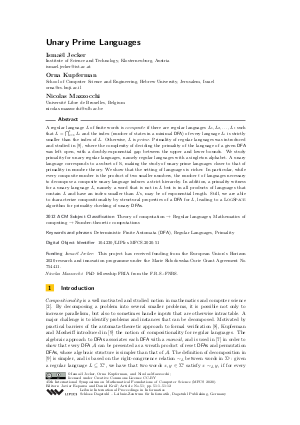Unary Prime Languages
Authors Ismaël Jecker, Orna Kupferman, Nicolas Mazzocchi
-
Part of:
Volume:
45th International Symposium on Mathematical Foundations of Computer Science (MFCS 2020)
Part of: Series: Leibniz International Proceedings in Informatics (LIPIcs)
Part of: Conference: Mathematical Foundations of Computer Science (MFCS) - License:
 Creative Commons Attribution 3.0 Unported license
Creative Commons Attribution 3.0 Unported license
- Publication Date: 2020-08-18
File

PDF
LIPIcs.MFCS.2020.51.pdf
- Filesize: 0.57 MB
- 12 pages
Document Identifiers
Subject Classification
ACM Subject Classification
- Theory of computation → Regular languages
- Mathematics of computing → Number-theoretic computations
Keywords
- Deterministic Finite Automata (DFA)
- Regular Languages
- Primality
Metrics
- Access Statistics
-
Total Accesses (updated on a weekly basis)
0Document
0Metadata
Abstract
A regular language L of finite words is composite if there are regular languages L₁,L₂,…,L_t such that L = ⋂_{i = 1}^t L_i and the index (number of states in a minimal DFA) of every language L_i is strictly smaller than the index of L. Otherwise, L is prime. Primality of regular languages was introduced and studied in [O. Kupferman and J. Mosheiff, 2015], where the complexity of deciding the primality of the language of a given DFA was left open, with a doubly-exponential gap between the upper and lower bounds. We study primality for unary regular languages, namely regular languages with a singleton alphabet. A unary language corresponds to a subset of ℕ, making the study of unary prime languages closer to that of primality in number theory. We show that the setting of languages is richer. In particular, while every composite number is the product of two smaller numbers, the number t of languages necessary to decompose a composite unary language induces a strict hierarchy. In addition, a primality witness for a unary language L, namely a word that is not in L but is in all products of languages that contain L and have an index smaller than L’s, may be of exponential length. Still, we are able to characterize compositionality by structural properties of a DFA for L, leading to a LogSpace algorithm for primality checking of unary DFAs.
Cite As Get BibTex
Ismaël Jecker, Orna Kupferman, and Nicolas Mazzocchi. Unary Prime Languages. In 45th International Symposium on Mathematical Foundations of Computer Science (MFCS 2020). Leibniz International Proceedings in Informatics (LIPIcs), Volume 170, pp. 51:1-51:12, Schloss Dagstuhl – Leibniz-Zentrum für Informatik (2020)
https://doi.org/10.4230/LIPIcs.MFCS.2020.51
BibTex
@InProceedings{jecker_et_al:LIPIcs.MFCS.2020.51,
author = {Jecker, Isma\"{e}l and Kupferman, Orna and Mazzocchi, Nicolas},
title = {{Unary Prime Languages}},
booktitle = {45th International Symposium on Mathematical Foundations of Computer Science (MFCS 2020)},
pages = {51:1--51:12},
series = {Leibniz International Proceedings in Informatics (LIPIcs)},
ISBN = {978-3-95977-159-7},
ISSN = {1868-8969},
year = {2020},
volume = {170},
editor = {Esparza, Javier and Kr\'{a}l', Daniel},
publisher = {Schloss Dagstuhl -- Leibniz-Zentrum f{\"u}r Informatik},
address = {Dagstuhl, Germany},
URL = {https://drops.dagstuhl.de/entities/document/10.4230/LIPIcs.MFCS.2020.51},
URN = {urn:nbn:de:0030-drops-127177},
doi = {10.4230/LIPIcs.MFCS.2020.51},
annote = {Keywords: Deterministic Finite Automata (DFA), Regular Languages, Primality}
}
Author Details
Funding
- Jecker, Ismaël: This project has received funding from the European Union’s Horizon 2020 research and innovation programme under the Marie Skłodowska-Curie Grant Agreement No. 754411.
- Mazzocchi, Nicolas: PhD fellowship FRIA from the F.R.S.-FNRS.
References
-
A. Cobham. On the base-dependence of sets of numbers recognizable by finite automata. Math. Systems Theory, 3:186?192, 1969.

-
W-P. de Roever, H. Langmaack, and A. Pnueli, editors. Compositionality: The Significant Difference. Proceedings of Compositionality Workshop, volume 1536 of Lecture Notes in Computer Science. Springer, 1998.

-
P. Gazi. Parallel decompositions of finite automata. Master’s thesis, Comenius University, Bratislava, Slovakia, 2006.

-
Y.-S. Han, A. Salomaa, K. Salomaa, D. Wood, and S. Yu. On the existence of prime decompositions. Theoretical Computer Science, 376:60-69, 2007.

-
G.H. Hardy and E.M. Wright. An introduction to the theory of numbers. Oxford university press, 1979.

-
F. Klaedtke and H. Rueß. Monadic second-order logics with cardinalities. In Proc. 30th Int. Colloq. on Automata, Languages, and Programming, volume 2719 of Lecture Notes in Computer Science, pages 681-696. Springer, 2003.

-
K. Krohn and J. Rhodes. Algebraic theory of machines. i. prime decomposition theorem for finite semigroups and machines. Transactions of the American Mathematical Society, 116:450-464, 1965.

-
O. Kupferman, R.P. Kurshan, and M. Yannakakis. Existance of reduction hierarchies. In Proc. 6th Annual Conf. of the European Association for Computer Science Logic, volume 1414 of Lecture Notes in Computer Science, pages 327-340. Springer, 1997.

-
O. Kupferman and J. Mosheiff. Prime languages. Information and Computation, 240:90-107, 2015.

-
J. Myhill. Finite automata and the representation of events. Technical Report WADD TR-57-624, pages 112-137, Wright Patterson AFB, Ohio, 1957.

-
A. Nerode. Linear automaton transformations. Proceedings of the American Mathematical Society, 9(4):541-544, 1958.

-
A. Netser. Decomposition of safe langauges. Amirim Research Prohect, The Hebrew University, 2018.

